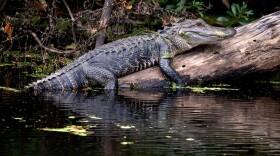Concrete pipes damaged by hurricanes Matthew and Florence will find a new purpose off the coast of North Carolina.
More than 1,000 tons of pipe will be used to help shore up two artificial reefs that are off the coast of Brunswick County, according to the N.C. Department of Transportation.
The department partnered with the N.C. Division of Marine Fisheries in an effort to find a new, cost-effective use for the damaged pipes that will help marine life.
The reefs are structures that replicate the ecological functions of food and refuge fish and other marine life need to survive, according to an NCDOT news release. Concrete is just one of the materials used in creating the more than 40 reefs off the coast. Others include such material as steel hulls from old tugboats and bridge demolition debris.
It's great for both the ecosystem and for angler fishermen.David Snead, Coastal Conservation Association of North Carolina
This shipment of material came from discarded culverts that had been stored at the NCDOT’s maintenance yard in Columbus County. Staff from that facility hauled the pipes to the Port of Wilmington. According to the marine fisheries division, which oversees the reef program, a marine contractor will use a barge this spring to transport and unload the material at reefs offshore from Oak Island and the town of Shallotte.
The material will be used to make three-dimensional structures, as well as, to create a sparse field on the ocean floor consisting of the pipes. This diversity of designs allows for the reefs to flourish as habitats, said Jordan Byrum, who has been the artificial reef coordinator at the marine fisheries division since 2018.
Recently, more than 100 tons of similarly damaged pipes were sent to the port from Bladen County to be used for the same purpose.
A 'win-win' situation
The idea for donating the pipes was forged during a conference for coastal resiliency, according to Ken Clark, NCDOT’s district engineer in Columbus County.
“We had considered many options on how to properly dispose of this unusable material, when we formed this unique collaboration with the Division of Marine Fisheries last year," Clark stated in an NCDOT news release. “This program mutually benefits both state agencies."

As for additional environmental impact from possibly contaminated concrete, Byrum said the material that is used must meet EPA and state environmental quality standards. He said concrete has been used in the artificial reef program for the past 40 years.
"In the past, we’ve used freshly made damaged concrete from commercial concrete pipe plants so there was no contamination,” Byrum said.
Disposing of the material in a construction and demolition landfill would have cost the NCDOT $65,000 in tipping fees. To avoid having to pay those fees, the department used dump trucks and trailers to haul the material from Columbus County to the port.
The funding for storing the pipes at the port and delivering them out to the artificial reefs is covered by fees collected by the state from recreational fishing licenses, Byrum said.
David Sneed, executive director of the Coastal Conservation Association of North Carolina said his organization is very supportive of the artificial reef program and the materials used to make the reefs. He called it a "win-win situation."
"It's great for both the ecosystem and for angler fishermen," Snead said.
Snead added that the reefs make great structures for fish and they help grow fish stock.
The CCA of NC is a community of conservationists and recreational anglers working to promote sound management of public trust marine and estuarine resources to protect those resources for the enjoyment of current and future generations, according to its website.
In addition to the artificial reefs, The Division of Marine Fisheries also maintains 25 estuarine reefs, 14 of which serve as oyster sanctuaries. These estuarine sites are found in Pamlico Sound and its tributaries, Bogue Sound, the New River, and the Cape Fear River.
A 2020 study by the National Oceanic and Atmosphere Administration found that natural and artificial reefs perform similarly as fish habitats. For the artificial variety, the location and material used to construct them may lead some to perform better than others.






